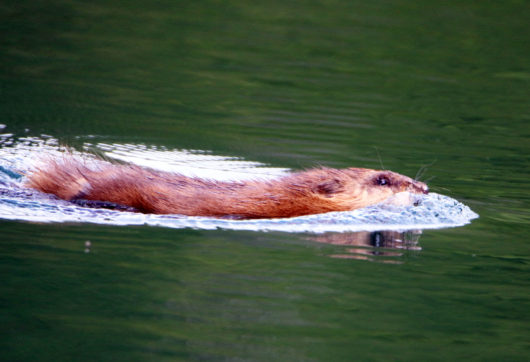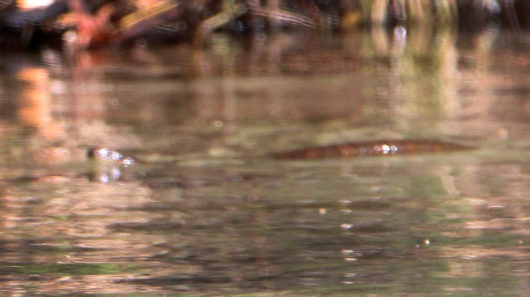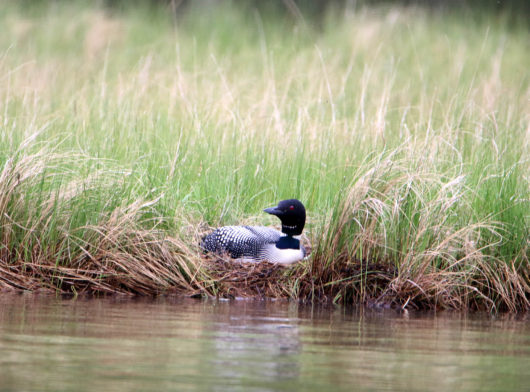We spotted this spotted sandpiper in Ghost Bay. He was teeter-tottering along, like these petite (7-8 inches) shorebirds do, picking at stuff with his bill. He startled when we paddled into the Bay. But once he settled back down he actually landed closer to us than when we first saw him. He has a distinctive black line from his bill across his eye and a nice clear white eye-ring. It’s spring, so this spotted sandpiper is, well, spotted. Just before the fall migration, which extends as far south as Bolivia and Brazil, Spotted Sandpipers molt and that nice spotted belly becomes spotless.
This beaver was swimming in Ghost Bay recently. You might be able to spot him yourself. We’re hoping to get to know him, as an individual, because he has a very distinctive reddish coat. And he’s got almost a white patch on the lower half of his face. He didn’t issue any alarm call.
The beavers have been busy this year. Once the ice melted, we can see that each of the lodges on the lake experienced a building boom.
This next guy doesn’t quite rival the beaver in swimming ability, but he’s no slouch. It’s an adult Northern Water Snake. First is a view of his not so beautiful head. We can tell he was an adult because his banding was not as distinctive as a young snake would be. And he was pretty big.
These snakes can live from 10-15 years and grow to about 3 and one-half feet long.
Here’s a view of him where you can see his length.
This guy wasn’t cooperating with Steve’s photography efforts. Doesn’t it remind you of some of those Loch Ness monster photos you’ve seen?
Northern Water Snakes a/k/a Nerodia Sipedon aren’t venomous. They will bite if you mess with them. But you have to make a total pest of yourself before that will happen. And if they bite you you’ll need antiseptic and a band-aid, not an undertaker. Don’t handle them, though. What they mostly do is release a foul-smelling substance that apparently you will not want to smell twice in your life. Here’s a view of a younger snake that we saw on the lake a few years ago.
We don’t see many water snakes. They do no harm to humans. They do no harm to game fish populations. They are good snakes who’ve been preyed upon mercilessly by humans who don’t like snakes (by the way, they scare me too) and who think they may be deadly Water Moccasins (Cottonmouths). We don’t have any Water Moccasins in Michigan. Not even one. We do have Eastern Massasauga Rattlesnakes, but even our rattlesnakes haven’t killed anyone in a zillion years. “Welcome to Pure Michigan: our snakes won’t kill you.” So let’s count ourselves lucky to have a few Northern Water Snakes on Long Lake and just give them some elbow room.
And speaking of giving critters elbow room, the loon pair in the lower lake is nesting. If we and our dogs can all stay clear and let them nest in peace, by mid-July we might be meeting a chick or two.







